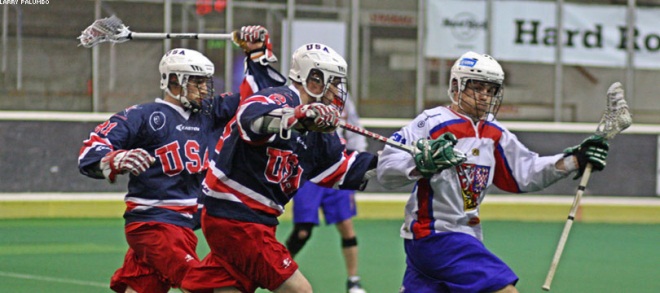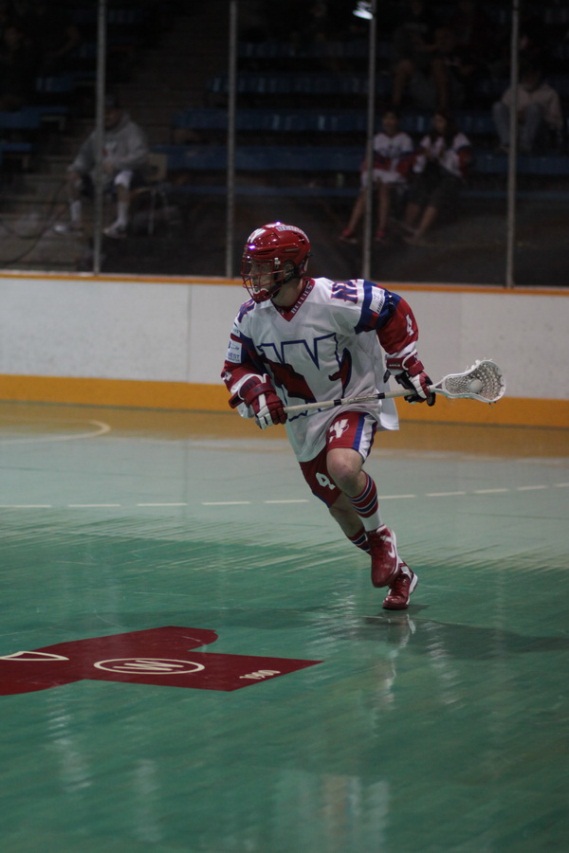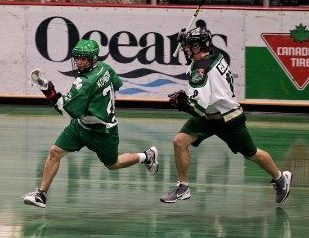Fundamental Skills Analysis
Cradling & Ball Protection:
-
-
- Generally, two hands are at opposite ends of the stick (one at the “butt-end,” the other just below the stick “head” at the "throat"), at approximately waist height, while "cradling" the lacrosse ball on the floor. In the offensive zone, players will often times move their hands above their head and closer together (shoulder-width) into what's known as the triple threat position, while threatening to shoot, "shopping" to pass, or setting up a dodge.
-
The stick should be held with a relaxed grip at the base of a players fingers, with the biceps of the player's top hand bent at 90 degrees. The cradling action involves moving only one's top hand to manipulate the stick (the upper arm (humerus) should have very little movement), in an up and down motion (wrist flexion & extension), rolling it from the base of the fingers to their fingertips; eventually adding the wrist (forearm) in an open and closed type motion ("rock the baby"). As this wrist is cradling up, ones hand/fingers should be curling in (flexion) and as the wrist is cradling down ones hand/fingers should be extending back (extension). The bottom hand acts as a guide (forming a hollow circle "doughnut" around the butt-end of the stick) and should move very little (if at all), other than to clench the stick handle when required (i.e. passing, shooting, sustaining defensive pressure, etc.).
These fine motor skills also need to be timed appropriately with the stride and movements of the player (in sync) when it comes to game play (i.e. when running). Lastly, players should learn to use their body position and arms to “protect the ball,” keeping their “stick tight” to their body and away from any defenders.

One-Handed Cradle:
-
- From a 2-handed cradle, the bottom hand can easily be removed, using this arm instead to protect the ball and stick, usually in the “open floor.” Players must beware not to push-off with their “free-arm” which is a form of “minor interference” and a loss of possession. This is an intermediate skill that should be discouraged to beginners.
One hand, or the other, is on the stick just below the stick head (it is a bad habit to one-handed cradle with a hand halfway down the shaft or lower; an easy strip). The hand to be used is determined as follows: the player with the ball attempts to keep themselves between the defender and the ball (i.e. protecting the ball).
From a vertical position, the action of the hand on the stick is then to move the stick back and forth between the mid-line (wrist flexion) and the outside of the body (wrist extension). The other hand not on the stick can be used to shield opponents from the ball, although players also need to be weary of a "push-off" call in this situation.
Keep in mind that it usually takes “two-hands” to score a goal. Thus, this technique is generally used only as a means of creating space for oneself, most often in transition, otherwise two-handed cradling is predominantly used.
Dodging:
-
- A dodge is a quick movement (or fake movement), usually toward the opponents net, with or without the ball, using quick foot and sometimes arm/hand movements; starting at roughly a sticks length away from a defender. Successful dodges are usually set up with changes in speed/direction, and also see the player come out of the dodge with speed/power. There are many different styles of dodges, described primarily by the action taken toward the net.
The "face dodge" is one of the most common dodges in box lacrosse whereby a ball carrier brings the ball from the triple threat position to across their face/body, rotating their hips and accelerating out of the dodge, all while keeping the ball in their strong-side. Other common dodges include roll dodges, hitch steps, stutter steps and bull dodges.
These move and others are utilized to get around aggressive defenders or to free up time & space for a quality shot. Where possible, offensive players should attack the butt-end of the defender’s stick ("away from their stick"). If they manage to get a step underneath of the defender after the face dodge, they will need to be weary of the trail check (ball protection) as they try to get a shot to the goalie's far-side, if possible. Otherwise, players should curl out into the corner if they can't get a good angle to the net, and keep the ball moving.
- Categories: Free / Beginner / Drillbook / Cradling

